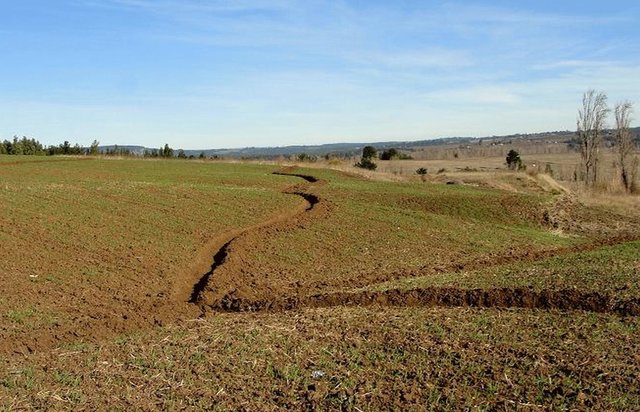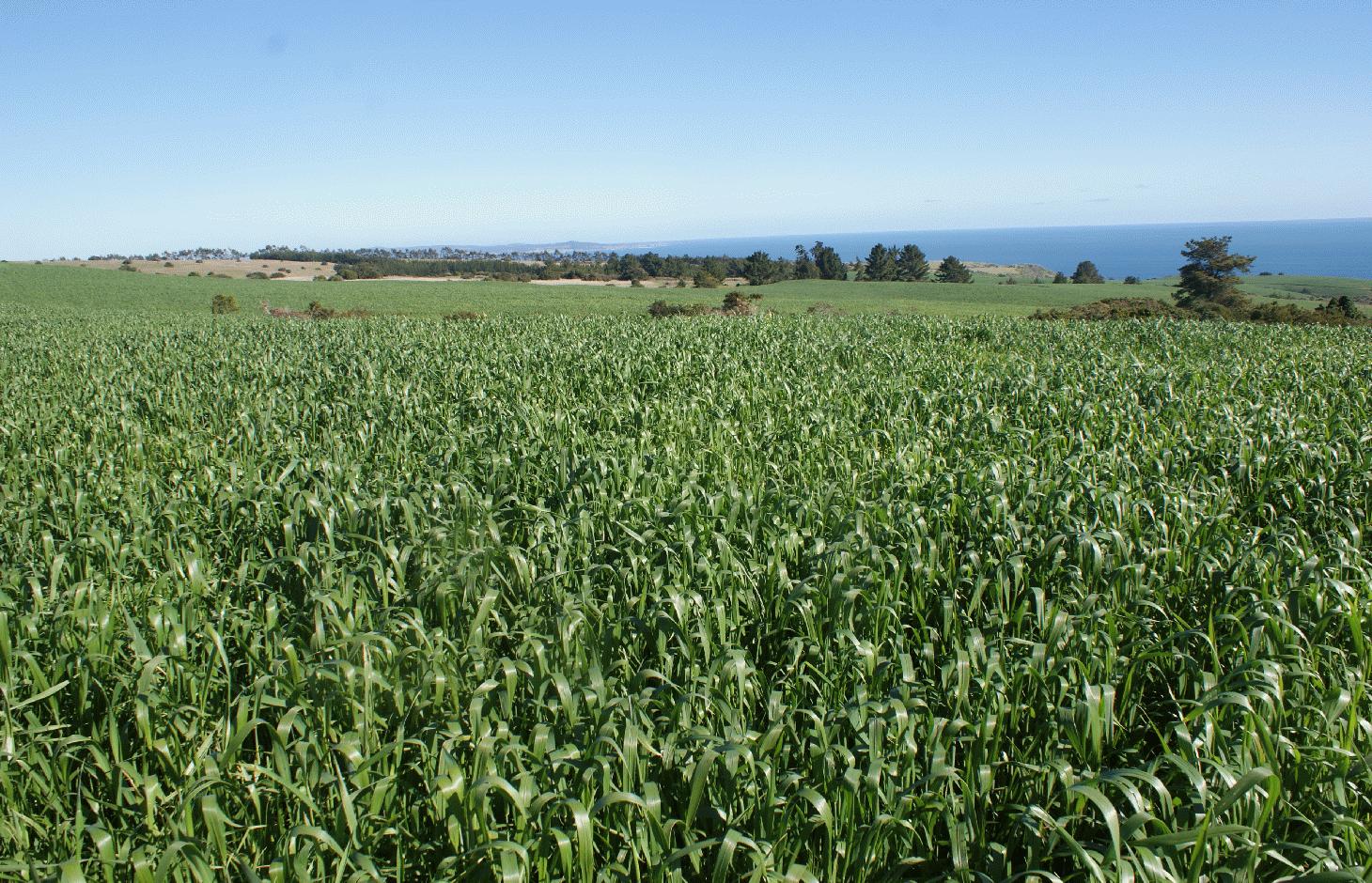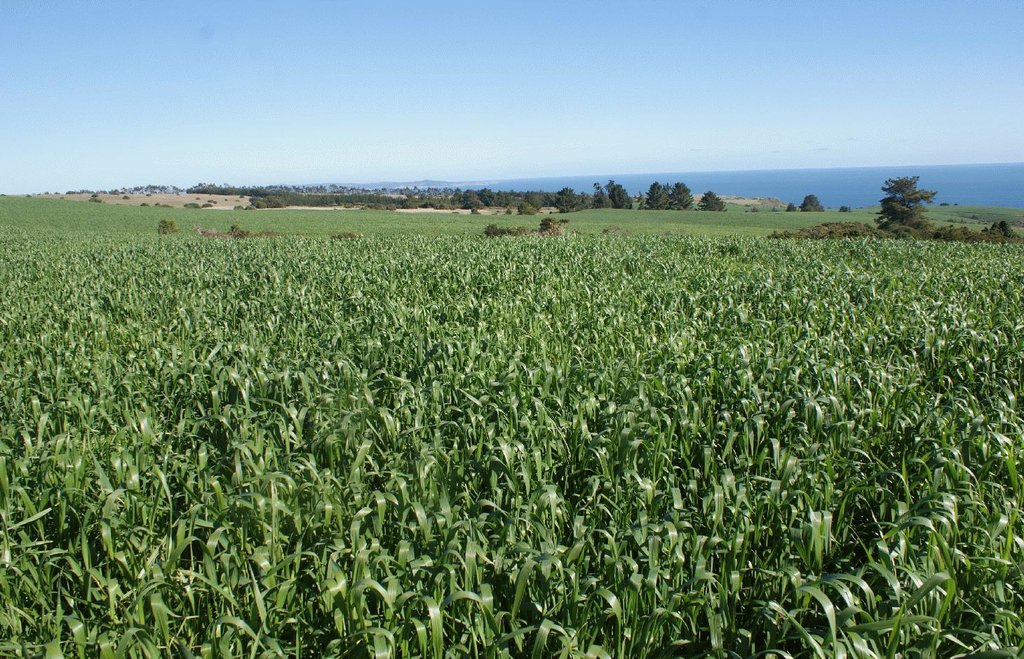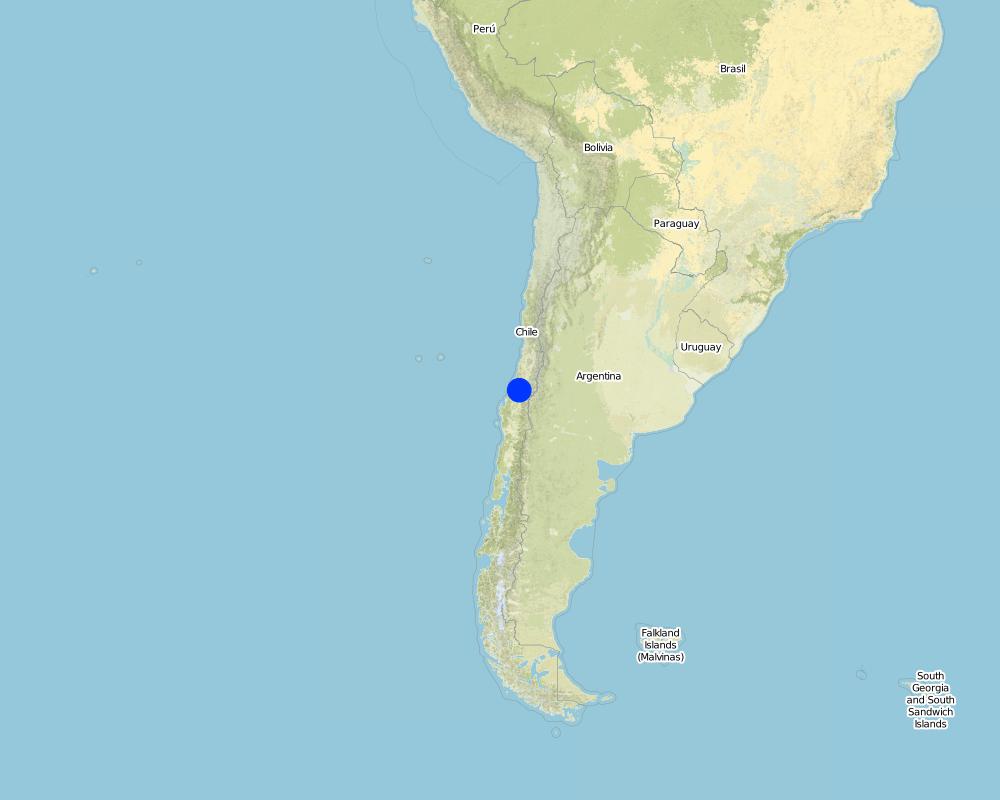Crop rotation with legumes [ชิลี]
- ผู้สร้างสรรค์:
- การอัพเดท:
- ผู้รวบรวม: Carlos Ovalle
- ผู้เรียบเรียง: –
- ผู้ตรวจสอบ: Deborah Niggli, Alexandra Gavilano
Rotación de cultivos con leguminosas (Spanish)
technologies_1123 - ชิลี
ดูส่วนย่อย
ขยายทั้งหมด ย่อทั้งหมด1. ข้อมูลทั่วไป
1.2 รายละเอียดที่ติดต่อได้ของผู้รวบรวมและองค์กรที่เกี่ยวข้องในการประเมินและการจัดเตรียมทำเอกสารของเทคโนโลยี
ผู้เชี่ยวชาญ SLM:
Soledad Espinoza
Instituto de Investigaciones Agropecuarias
ชิลี
ชื่อของโครงการซึ่งอำนวยความสะดวกในการทำเอกสารหรือการประเมินเทคโนโลยี (ถ้าเกี่ยวข้อง)
DESIRE (EU-DES!RE)ชื่อขององค์กรซึ่งอำนวยความสะดวกในการทำเอกสารหรือการประเมินเทคโนโลยี (ถ้าเกี่ยวข้อง)
Instituto de Investigaciones Agropecuarias (INIA) (Instituto de Investigaciones Agropecuarias (INIA)) - ชิลี1.3 เงื่อนไขการใช้ข้อมูลที่ได้บันทึกผ่านทาง WOCAT
ผู้รวบรวมและวิทยากรหลักยอมรับเงื่อนไขเกี่ยวกับการใช้ข้อมูลที่ถูกบันทึกผ่านทาง WOCAT:
ใช่
1.5 Reference to Questionnaire(s) on SLM Approaches (documented using WOCAT)

Dissemination of soil conservation technologies in dryland areas [ชิลี]
Dissemination of no tillage with subsoiling in the Municipality of Yumbel
- ผู้รวบรวม: Carlos Ovalle
2. การอธิบายลักษณะของเทคโนโลยี SLM
2.1 การอธิบายแบบสั้น ๆ ของเทคโนโลยี
คำจำกัดความของเทคโนโลยี:
Biological Nitrogen Fixation (BNF) of legumes as a source of N in crop rotations with cereals in Mediterranean Chile
2.2 การอธิบายแบบละเอียดของเทคโนโลยี
คำอธิบาย:
In the past, legumes were commonly used as a biological and economic source of N for farming systems. Nowadays, N-fixing legumes have been recovering as viable crops because of the increased cost of N fertilizer and the need to develop more sustainable farming systems.
Purpose of the Technology: These systems combine phases of legumes of different duration, in which N is fixed and accumulates in the soil, followed by phases of cereal growing during which accumulated N is extracted
Establishment / maintenance activities and inputs: In this new rotation for rainfed agricultural systems in Central Chile, four legume-wheat rotations were compared to a monoculture crop rotation (wheat followed by oat). The legume species are: the narrow-leaf lupin (Lupinus angustifolium); Wonga (early-flowering and high-yielding narrow-leafed lupin variety), yellow lupin (Lupinus luteus); Motiv, Peas (Pisum sativum); Rocket and a fodder mixture of vetch (Vicia atropurpurea) with oats. Legume seeds were inoculated with a specific Rhizobium. In the year following the legume crop, wheat was seeded without N fertilisation on the incorporated residues of grain legumes and green manure (vetch with oats). The BNF in the grain legumes varies from 124 to 178 kg N ha-1, depending on the type of legume. Peas are the most efficient fixing legume crop. In the lupins - wheat (L. angustifolius) rotation without application of N to the wheat after lupins, production of wheat was between 79 and 110% of that when fertilised with N. In the peas - wheat rotation, a yield equivalent to 72 and 105% of the wheat fully fertilised with N was obtained. While peas (Pisum sativum) can be eaten as a green vegetable, lupins and Vicia are used as fodder supplements for animals.
Natural / human environment: The new rotations were developed and evaluated experimentally. Then, through a technology transfer programme, the technology was transferred to real conditions with farmers in a programme covering 250 ha in the municipality of Yumbel.
The area has a subhumid Mediterranean climate with an average annual precipitation of 695 mm (80% concentrated in winter), with five months of drought. Soils are Alfisols of the Cauquenes type, classified as Ultic Palexeralfs. The soil is formed from weathered granite with moderately acidic conditions and low organic carbon. Clay content in the soil is 15% at depths of 0-18 cm depth. Below this depth, it is above 44%. The topography comprises a hillslope with a gradient of 10-20 % and the main traditional crop rotation is oat-wheat or wheat-natural pasture. The farmers are smallholders working on their own land. The sizes of the holdings on the dryland soils vary from 5 to 20 ha.
2.3 รูปภาพของเทคโนโลยี
2.5 ประเทศภูมิภาค หรือสถานที่ตั้งที่เทคโนโลยีได้นำไปใช้และได้รับการครอบคลุมโดยการประเมินนี้
ประเทศ:
ชิลี
ภูมิภาค/รัฐ/จังหวัด:
Cauquenes and Bíobio
ข้อมูลจำเพาะเพิ่มเติมของสถานที่ตั้ง :
Secano interior, Mediterranean Chile
ระบุการกระจายตัวของเทคโนโลยี:
- กระจายไปอย่างสม่ำเสมอในพื้นที่
If the Technology is evenly spread over an area, specify area covered (in km2):
250.0
แสดงความคิดเห็น:
Total area covered by the SLM Technology is 250 km2
Map
×2.6 วันที่การดำเนินการ
ถ้าไม่รู้ปีที่แน่นอน ให้ระบุวันที่โดยประมาณ:
- น้อยกว่า 10 ปี (ไม่นานนี้)
2.7 คำแนะนำของเทคโนโลยี
ให้ระบุว่าเทคโนโลยีถูกแนะนำเข้ามาอย่างไร:
- ในช่วงการทดลองหรือการทำวิจัย
- ทางโครงการหรือจากภายนอก
3. การจัดประเภทของเทคโนโลยี SLM
3.1 วัตถุประสงค์หลักของเทคโนโลยี
- อนุรักษ์ระบบนิเวศน์
3.2 ประเภทของการใช้ที่ดินในปัจจุบันที่ได้นำเทคโนโลยีไปใช้

พื้นที่ปลูกพืช
- การปลูกพืชล้มลุกอายุปีเดียว
Annual cropping - Specify crops:
- cereals - oats
- legumes and pulses - other
- legumes and pulses - peas
- vegetables - leafy vegetables (salads, cabbage, spinach, other)
- wheat
ระบุ:
Longest growing period in days: 180; Longest growing period from month to month: Mar - Nov
Is crop rotation practiced?
ใช่
แสดงความคิดเห็น:
The legume species are: the narrow-leaf lupin (Lupinus angustifolium); Wonga (early-flowering and high-yielding narrow-leafed lupin variety), yellow lupin (Lupinus luteus); Motiv, Peas (Pisum sativum); Rocket and a fodder mixture of vetch (Vicia atropurpurea) with oats
Major land use problems (compiler’s opinion): In rainfed areas of the Mediterranean region of Chile, bread wheat (Triticum aestivum) is mainly produced in rotation with oats (Avena sativa) and therefore N is obtained from the soil and synthetic N fertilizers applied during sowing and ploughing. These intensive crop rotations have resulted in deterioration of the physical properties and a depletion of soil fertility as a result of the drastic reduction in organic matter content of these soils.
3.5 กลุ่ม SLM ที่ตรงกับเทคโนโลยีนี้
- ระบบหมุนเวียน (การปลูกพืชหมุนเวียน การพักดิน การเกษตรแบบไร่เลื่อนลอย)
3.6 มาตรการ SLM ที่ประกอบกันเป็นเทคโนโลยี

มาตรการจัดการพืช
- A1: พืช/สิ่งปกคลุมดิน
3.7 รูปแบบหลักของการเสื่อมโทรมของที่ดินที่ได้รับการแก้ไขโดยเทคโนโลยี

การเสื่อมโทรมของดินทางด้านเคมี
- Cn (Fertility decline): ความอุดมสมบูรณ์และปริมาณอินทรียวัตถุในดินถูกทำให้ลดลงไป (ไม่ได้เกิดจากสาเหตุการกัดกร่อน)
แสดงความคิดเห็น:
Main type of degradation addressed: Cn: fertility decline and reduced organic matter content
Main causes of degradation: soil management, change in temperature, change of seasonal rainfall, Heavy / extreme rainfall (intensity/amounts), education, access to knowledge and support services
3.8 การป้องกัน การลดลง หรือการฟื้นฟูความเสื่อมโทรมของที่ดิน
ระบุเป้าหมายของเทคโนโลยีกับความเสื่อมโทรมของที่ดิน:
- ป้องกันความเสื่อมโทรมของที่ดิน
- ลดความเสื่อมโทรมของดิน
4. ข้อมูลจำเพาะด้านเทคนิค กิจกรรมการนำไปปฏิบัติใช้ ปัจจัยนำเข้า และค่าใช้จ่าย
4.1 แบบแปลนทางเทคนิคของเทคโนโลยี
ข้อมูลจำเพาะด้านเทคนิค (แบบแปลนทางเทคนิคของเทคโนโลยี):
Lupins forming part of the crop sequence (Lupinus angustifolium)
Technical knowledge required for land users: high
Main technical functions: increase in organic matter, increase in nutrient availability (supply, recycling,…), promotion of new crops and varieties
Secondary technical functions: improvement of ground cover
ผู้เขียน:
Soledad Espinoza
4.2 ข้อมูลทั่วไปเกี่ยวกับการคำนวณปัจจัยนำเข้าและค่าใช้จ่าย
ระบุสกุลเงินที่ใช้คำนวณค่าใช้จ่าย:
- USD
4.5 การบำรุงรักษาสภาพหรือกิจกรรมที่เกิดขึ้นเป็นประจำ
| กิจกรรม | ช่วงระยะเวลา/ความถี่ | |
|---|---|---|
| 1. | Seeding legumes | |
| 2. | Application of fertilizer | |
| 3. | Harvesting with special machinery |
4.6 ค่าใช้จ่ายของปัจจัยนำเข้าและกิจกรรมที่เกิดขึ้นเป็นประจำที่ต้องการการบำรุงรักษา (ต่อปี)
| ปัจจัยนำเข้า | หน่วย | ปริมาณ | ค่าใช้จ่ายต่อหน่วย | ค่าใช้จ่ายทั้งหมดต่อปัจจัยนำเข้า | %ของค่าใช้จ่ายที่ก่อให้เกิดขึ้นโดยผู้ใช้ที่ดิน | |
|---|---|---|---|---|---|---|
| แรงงาน | Seed, fertilize and harvest | ha | 1.0 | 146.0 | 146.0 | 100.0 |
| อุปกรณ์ | Rent seeder machine+harvesting | ha | 1.0 | 293.0 | 293.0 | 60.0 |
| วัสดุด้านพืช | Seeds | ha | 1.0 | 306.0 | 306.0 | 80.0 |
| ค่าใช้จ่ายทั้งหมดของการบำรุงรักษาสภาพเทคโนโลยี | 745.0 | |||||
| Total costs for maintenance of the Technology in USD | 745.0 | |||||
4.7 ปัจจัยสำคัญที่สุดที่มีผลกระทบต่อค่าใช้จ่าย
ปัจจัยสำคัญที่สุดที่มีผลกระทบต่อค่าใช้จ่ายต่างๆ:
There are not establishment inputs and costs because in annual crops all the cost are recurrent
5. สิ่งแวดล้อมทางธรรมชาติและของมนุษย์
5.1 ภูมิอากาศ
ฝนประจำปี
- < 250 ม.ม.
- 251-500 ม.ม.
- 501-750 ม.ม.
- 751-1,000 ม.ม.
- 1,001-1,500 ม.ม.
- 1,501-2,000 ม.ม.
- 2,001-3,000 ม.ม.
- 3,001-4,000 ม.ม.
- > 4,000 ม.ม.
เขตภูมิอากาศเกษตร
- กึ่งชุ่มชื้น
Thermal climate class: temperate
5.2 สภาพภูมิประเทศ
ค่าเฉลี่ยความลาดชัน:
- ราบเรียบ (0-2%)
- ลาดที่ไม่ชัน (3-5%)
- ปานกลาง (6-10%)
- เป็นลูกคลื่น (11-15%)
- เป็นเนิน (16-30%)
- ชัน (31-60%)
- ชันมาก (>60%)
ธรณีสัณฐาน:
- ที่ราบสูง/ที่ราบ
- สันเขา
- ไหล่เขา
- ไหล่เนินเขา
- ตีนเนิน
- หุบเขา
ระดับความสูง:
- 0-100 เมตร
- 101-500 เมตร
- 501-1,000 เมตร
- 1,001-1,500 เมตร
- 1,501-2,000 เมตร
- 2,001-2,500 เมตร
- 2,501-3,000 เมตร
- 3,001-4,000 เมตร
- > 4,000 เมตร
ความคิดเห็นและข้อมูลจำเพาะเพิ่มเติมเรื่องสภาพภูมิประเทศ:
Slopes on average: Also hilly
5.3 ดิน
ค่าเฉลี่ยความลึกของดิน:
- ตื้นมาก (0-20 ซ.ม.)
- ตื้น (21-50 ซ.ม.)
- ลึกปานกลาง (51-80 ซ.ม.)
- ลึก (81-120 ซ.ม.)
- ลึกมาก (>120 ซ.ม.)
เนื้อดิน (ดินชั้นบน):
- ละเอียด/หนัก (ดินเหนียว)
อินทรียวัตถุในดิน:
- ต่ำ (<1%)
(ถ้ามี) ให้แนบคำอธิบายเรื่องดินแบบเต็มหรือระบุข้อมูลที่มีอยู่ เช่น ชนิดของดิน ค่า pH ของดินหรือความเป็นกรดของดิน ความสามารถในการแลกเปลี่ยนประจุบวก ไนโตรเจน ความเค็ม เป็นต้น:
Soil fertility is very low
Soil drainage / infiltration is poor
Soil water storage capacity is very low
5.4 ความเป็นประโยชน์และคุณภาพของน้ำ
ระดับน้ำใต้ดิน:
5-50 เมตร
น้ำไหลบ่าที่ผิวดิน:
ไม่ดีหรือไม่มีเลย
คุณภาพน้ำ (ที่ยังไม่ได้บำบัด):
เป็นน้ำเพื่อการดื่มที่ดี
5.5 ความหลากหลายทางชีวภาพ
ความหลากหลายทางชนิดพันธุ์:
- ต่ำ
5.6 ลักษณะของผู้ใช้ที่ดินที่นำเทคโนโลยีไปปฏิบัติใช้
แนวทางการตลาดของระบบการผลิต:
- mixed (subsistence/ commercial)
รายได้ที่มาจากนอกฟาร์ม:
- > 50% ของรายได้ทั้งหมด
ระดับของความมั่งคั่งโดยเปรียบเทียบ:
- จน
เป็นรายบุคคล/ครัวเรือน:
- เป็นรายบุคคล/ครัวเรือน
เพศ:
- ชาย
ระบุลักษณะอื่นๆที่เกี่ยวข้องของผู้ใช้ที่ดิน:
Population density: 10-50 persons/km2
Annual population growth: < 0.5%
80% of the land users are poor and own 60% of the land.
5.7 Average area of land used by land users applying the Technology
- < 0.5 เฮกตาร์
- 0.5-1 เฮกตาร์
- 1-2 เฮกตาร์
- 2-5 เฮกตาร์
- 5-15 เฮกตาร์
- 15-50 เฮกตาร์
- 50-100 เฮกตาร์
- 100-500 เฮกตาร์
- 500-1,000 เฮกตาร์
- 1,000-10,000 เฮกตาร์
- >10,000 เฮกตาร์
5.8 กรรมสิทธิ์ในที่ดิน สิทธิในการใช้ที่ดินและสิทธิในการใช้น้ำ
กรรมสิทธิ์ในที่ดิน:
- รายบุคคล ไม่ได้รับสิทธิครอบครอง
สิทธิในการใช้ที่ดิน:
- รายบุคคล
สิทธิในการใช้น้ำ:
- รายบุคคล
5.9 การเข้าถึงบริการและโครงสร้างพื้นฐาน
สุขภาพ:
- จน
- ปานกลาง
- ดี
ความช่วยเหลือทางด้านเทคนิค:
- จน
- ปานกลาง
- ดี
การจ้างงาน (เช่น ภายนอกฟาร์ม):
- จน
- ปานกลาง
- ดี
พลังงาน:
- จน
- ปานกลาง
- ดี
ถนนและการขนส่ง:
- จน
- ปานกลาง
- ดี
น้ำดื่มและการสุขาภิบาล:
- จน
- ปานกลาง
- ดี
6. ผลกระทบและสรุปคำบอกกล่าว
6.1 ผลกระทบในพื้นที่ดำเนินการ (On-site) จากการใช้เทคโนโลยี
ผลกระทบทางด้านเศรษฐกิจและสังคม
การผลิต
การผลิตพืชผล
การผลิตพืชที่ใช้เลี้ยงปศุสัตว์
คุณภาพพืชที่ใช้เลี้ยงปศุสัตว์
การเสี่ยงต่อความล้มเหลวในการผลิต
ความหลากหลายของผลิตภัณฑ์
รายได้และค่าใช้จ่าย
รายได้จากฟาร์ม
ความหลากหลายของแหล่งผลิตรายได้
ภาระงาน
ผลกระทบด้านสังคมวัฒนธรรมอื่น ๆ
ความมั่นคงด้านอาหาร / พึ่งตนเองได้
สถานการณ์ด้านสุขภาพ
SLM หรือความรู้เรื่องความเสื่อมโทรมของที่ดิน
livelihood and human well-being
ผลกระทบด้านนิเวศวิทยา
ดิน
สิ่งปกคลุมดิน
การสูญเสียดิน
การเกิดแผ่นแข็งที่ผิวดิน /การเกิดชั้นดาน
การหมุนเวียนและการเติมของธาตุอาหาร
อินทรียวัตถุในดิน/ต่ำกว่าดินชั้น C
ความหลากหลายทางชีวภาพของพืชและสัตว์
มวลชีวภาพ/เหนือดินชั้น C
ผลกระทบด้านนิเวศวิทยาอื่น ๆ
hazard towards adverse events
6.2 ผลกระทบนอกพื้นที่ดำเนินการ (Off-site) จากการใช้เทคโนโลยี
น้ำที่ใช้ประโยชน์ได้
surface runoff
6.3 การเผชิญและความตอบสนองของเทคโนโลยีต่อการเปลี่ยนแปลงสภาพภูมิอากาศที่ค่อยเป็นค่อยไป และสภาพรุนแรงของภูมิอากาศ / ภัยพิบัติ (ที่รับรู้ได้โดยผู้ใช้ที่ดิน)
การเปลี่ยนแปลงสภาพภูมิอากาศที่ค่อยเป็นค่อยไป
การเปลี่ยนแปลงสภาพภูมิอากาศที่ค่อยเป็นค่อยไป
| ฤดู | increase or decrease | เทคโนโลยีมีวิธีการรับมืออย่างไร | |
|---|---|---|---|
| อุณหภูมิประจำปี | เพิ่มขึ้น | ดี |
สภาพรุนแรงของภูมิอากาศ (ภัยพิบัติ)
ภัยพิบัติจากสภาพภูมิอากาศ
| เทคโนโลยีมีวิธีการรับมืออย่างไร | |
|---|---|
| ภัยจากฝนแล้ง | ไม่ค่อยดี |
แสดงความคิดเห็น:
This technology should be complemented with no tillage and subsoiling of the soil (see QT CHL01).
6.4 การวิเคราะห์ค่าใช้จ่ายและผลประโยชน์ที่ได้รับ
ผลประโยชน์ที่ได้รับเปรียบเทียบกับค่าใช้จ่ายในการจัดตั้งเป็นอย่างไร (จากมุมมองของผู้ใช้ที่ดิน)
ผลตอบแทนระยะสั้น:
ด้านบวก
ผลตอบแทนระยะยาว:
ด้านบวก
ผลประโยชน์ที่ได้รับเปรียบเทียบกับค่าใช้จ่ายในการบำรุงรักษาหรือต้นทุนที่เกิดขึ้นซ้ำอีก เป็นอย่างไร (จากมุมมองของผู้ใช้ที่ดิน)
ผลตอบแทนระยะสั้น:
ด้านบวก
ผลตอบแทนระยะยาว:
ด้านบวก
6.5 การปรับตัวของเทคโนโลยี
แสดงความคิดเห็น:
Comments on acceptance with external material support: This is a new approach to the cereal production system in rainfed areas. Initially the adoption has been slow, as the results obtained in the project are recent.
Comments on adoption trend: . Hence it is expected that in the future the adoption of this technology increases up to 20,000 ha in the “secano interior” of south-central Chile
6.7 จุดแข็ง / ข้อได้เปรียบ / โอกาสของเทคโนโลยี
| จุดแข็ง / ข้อได้เปรียบ / โอกาสในทัศนคติของผู้รวบรวมหรือวิทยากรหลัก |
|---|
|
Reduces the costs of fertiliser: the incorporation of legumes in the rotation cycle means a saving of 30% of nitrogen fertilizer in cereal production costs How can they be sustained / enhanced? keep the phases of legumes sufficiently frequent and long |
| Increases the economic benefits. When analysing the whole farming system, replacing the traditional rotation of wheat followed by natural pasture, implies two economic benefits for the producer: increasing the income by the incorporation of a new crop (legumes) and the reduction of costs in the fertilization of cereals. |
|
Increase soil organic matter: the new rotation system means a new concept in the management of crop residues. These should be incorporated into the soil, which in the medium and long term will involve an increase in the soil organic matter content How can they be sustained / enhanced? ensure application of the new management of crop residues |
| The new rotation system involves an increase in productivity of the land, as it incorporates new cultures and improves the physical and chemical conditions of the soils. |
6.8 จุดอ่อน / ข้อเสียเปรียบ / ความเสี่ยงของเทคโนโลยีและวิธีการแก้ไข
| จุดอ่อน / ข้อเสียเปรียบ / ความเสี่ยงในทัศนคติของผู้รวบรวมหรือวิทยากรหลัก | มีวิธีการแก้ไขได้อย่างไร |
|---|---|
| Necessity of more training for the farmers | improve / enhance agricultural extension |
7. การอ้างอิงและการเชื่อมต่อ
7.1 วิธีการและแหล่งข้อมูล
7.2 การอ้างอิงถึงสิ่งตีพิมพ์
หัวข้อ, ผู้เขียน, ปี, หมายเลข ISBN:
Espinoza, S., Ovalle, C., del Pozo, A., Zagal, E., Urquiaga, S. 2011. Biological Fixation of N2 in mono and polyspecific legume pasture in the humid Mediterranean zone of Chile. Chilean Journal of Agricultural Research. 71(1):132-139.
ลิงก์และโมดูล
ขยายทั้งหมด ย่อทั้งหมดลิงก์

Dissemination of soil conservation technologies in dryland areas [ชิลี]
Dissemination of no tillage with subsoiling in the Municipality of Yumbel
- ผู้รวบรวม: Carlos Ovalle
โมดูล
ไม่มีโมดูล






